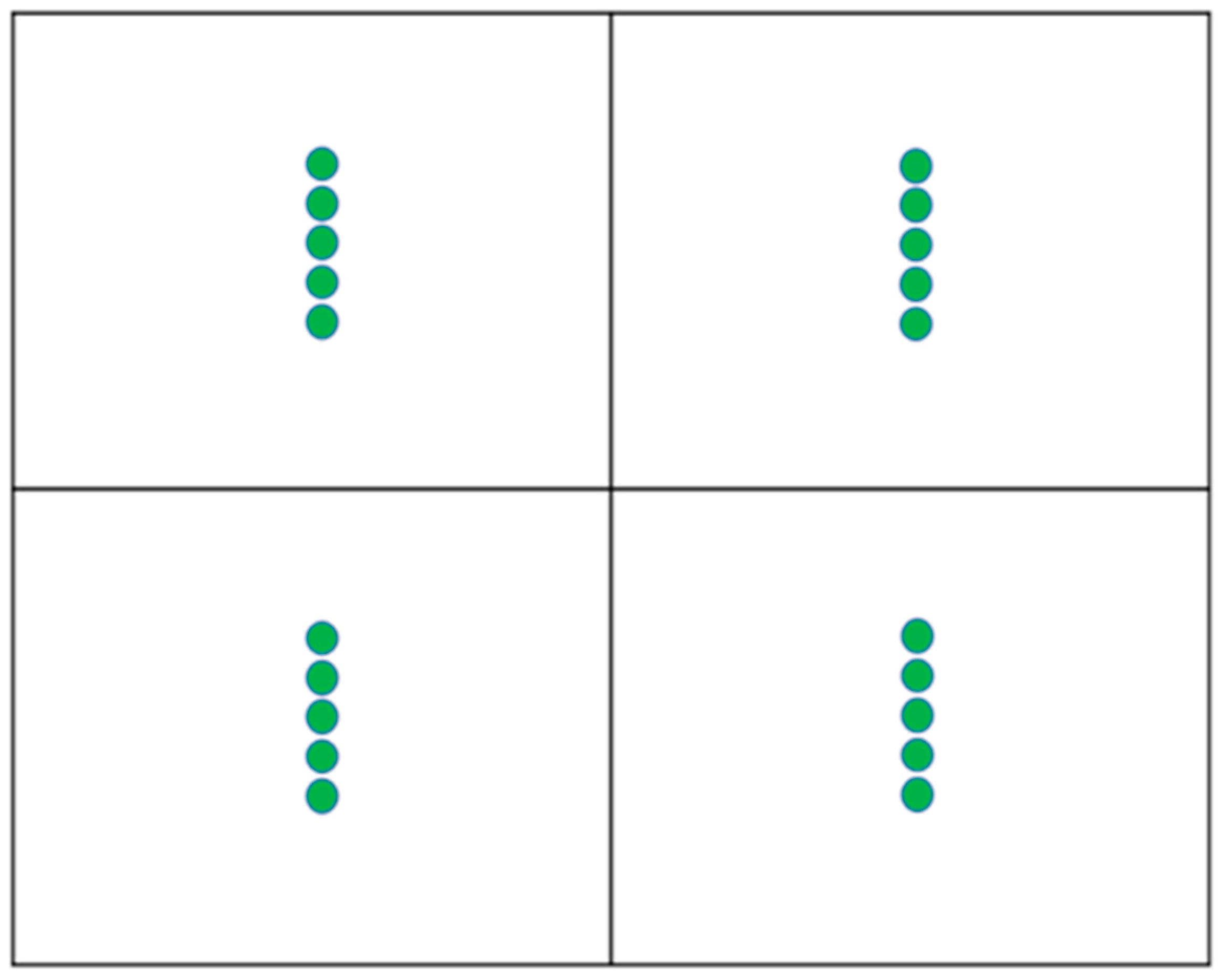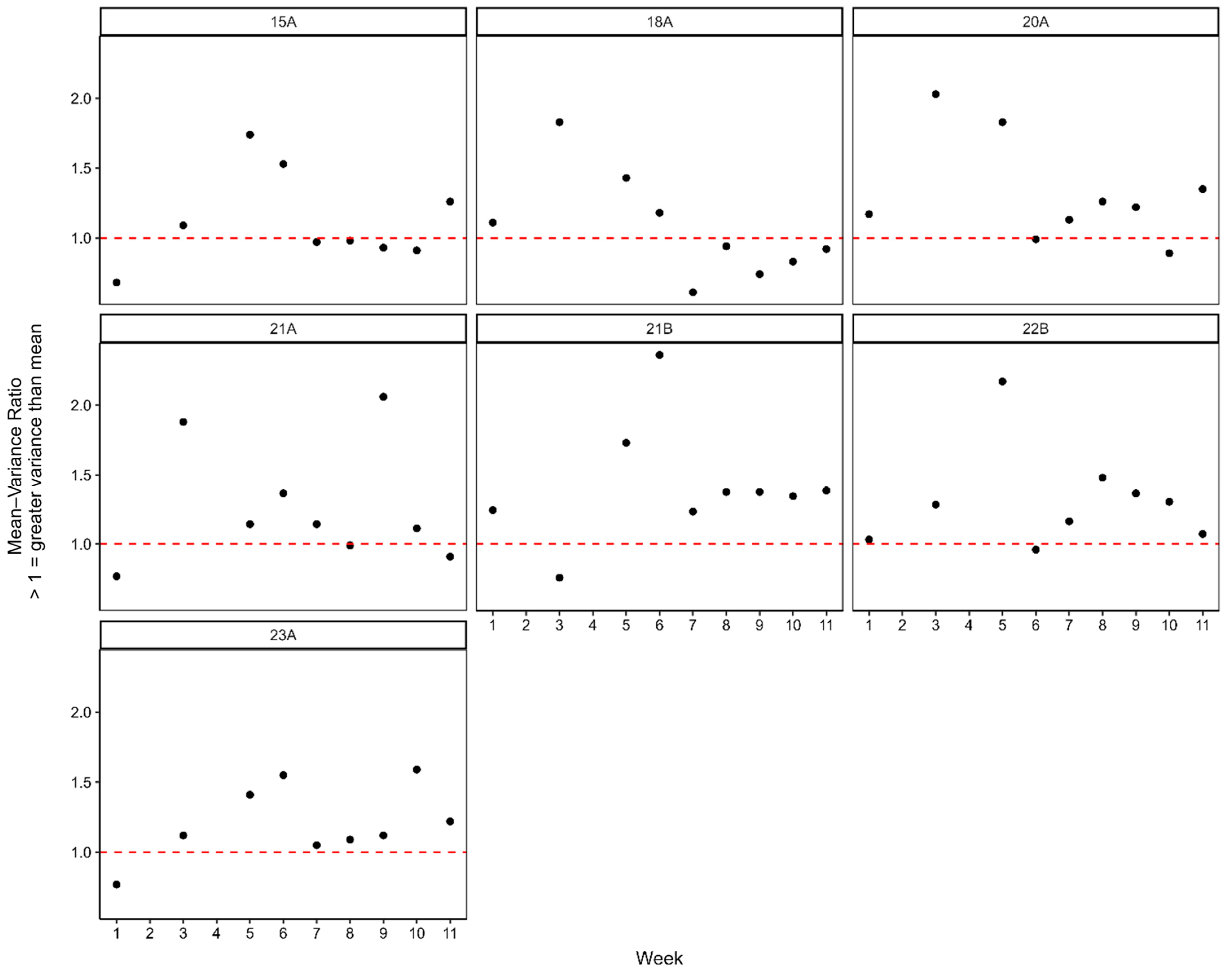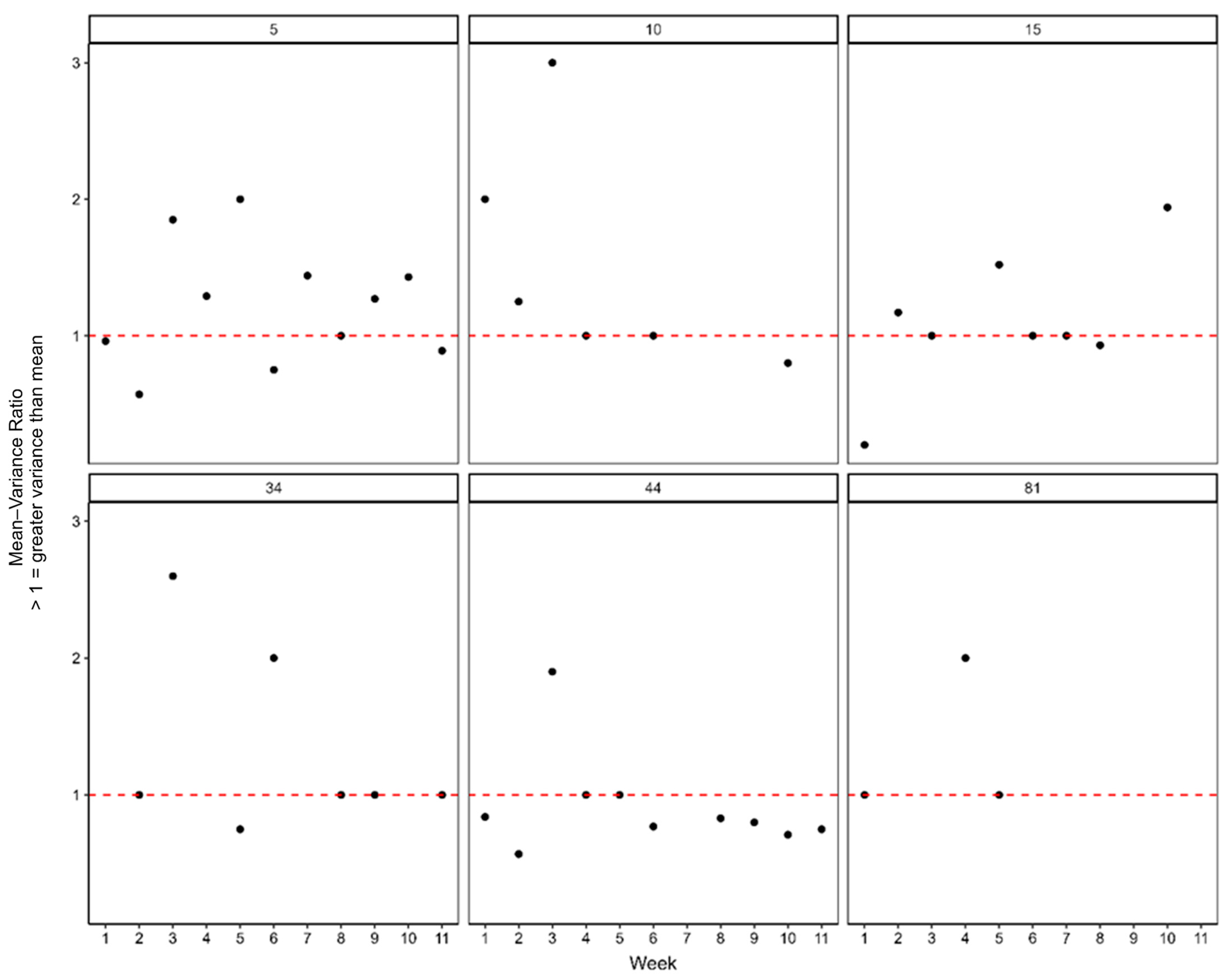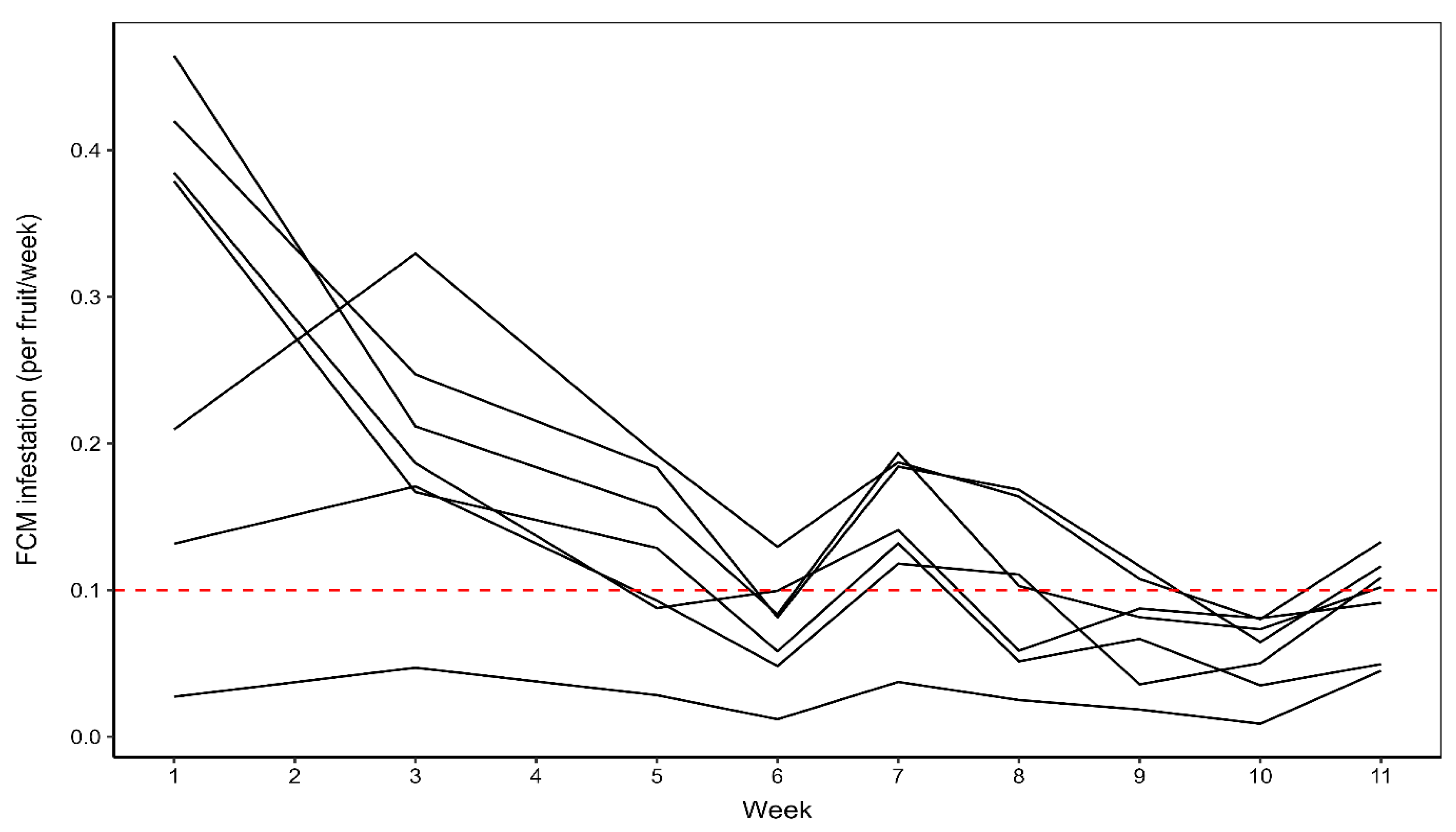1. Introduction
South Africa is the second largest exporter of citrus globally, and the largest global shipper of fresh citrus fruit. South Africa accounts for around 10% of global citrus fresh fruit exports, with approximately 71% of South Africa’s citrus production being exported [
1,
2]. Europe is the largest market for South African citrus exports, comprising 36% of the country’s export volumes [
1].
Thaumatotibia leucotreta (Meyrick, 1913) (Lepidoptera: Tortricidae), also known as false codling moth (FCM), is endemic to sub-Saharan Africa [
3] and is a regulated phytosanitary pest for certain export markets, including the European Union (EU) since January 2018 [
4]. Effective
T. leucotreta infestation risk mitigation procedures are accordingly required to sustain exports. A systems approach for
T. leucotreta [
5,
6] was developed and implemented as an alternative to standalone postharvest disinfestation treatments. The use of systems approaches is guided by the International Standards for Phytosanitary Measures (ISPM 14) of the International Plant Protection Convention (IPPC) [
7], as a procedure/treatment to manage the risk of quarantine pests, and its use is provided for in EU phytosanitary regulations [
4,
8,
9]. A systems approach is defined as the integration of control measures, which may entail preharvest and postharvest actions, with at least two measures working independently from one another to provide adequate quarantine security [
7,
10]. The development of a systems approach for
T. leucotreta was reported by Moore et al. [
5], using three independent measures, including 13 distinct components or steps. This system was officially implemented by South Africa in 2018 for the export of fresh citrus from South Africa to the EU. The system was later validated and improved by Hattingh et al. [
6], who demonstrated the system to be at least as effective as a standalone Probit 9 efficacy disinfestation treatment. The three measures in the systems are as follows: (1) preharvest controls and measurements, post-picking sampling, inspection and packing house measures; (2) post-packing sampling and inspection; and (3) shipping conditions [
6].
One of the components within Measure 1 of the systems approach that can be used to categorise the phytosanitary status of the orchard is the monitoring of fruit infestation in the orchard for at least the last 12 weeks before harvesting begins, with associated infestation thresholds [
5,
6]. If the threshold is exceeded during the period 12 to 4 weeks before start of harvest, the orchard requires a corrective treatment, and if it is exceeded during the last 4 weeks before harvesting begins, the range of available shipping condition options is reduced to provide a higher level of risk mitigation. In the monitoring system originally used in the systems approach, fallen fruit from underneath five data trees per orchard were collected and analysed during the 12 week period before start of harvesting [
6], with a sliding scale for additional sets of five data trees per orchard applied to increasing orchard size (unpublished systems approach protocol). It was recommended that the data trees be placed together and positioned in the orchard wherever fruit drop shows the highest level of infestation. The infestation threshold was originally set at an average of more than 0.2 infested fruit per tree per week [
5,
6], but was subsequently revised to an average of no more than 0.1 infested fruit per tree per week (unpublished systems approach protocol).
Although the
T. leucotreta infestation level recorded preharvest is not itself used in calculating the efficacy of the systems approach [
6], the threshold associated with the monitoring system contributes to the categorisation of the phytosanitary status of the orchard, which in turn influences the range of options available in subsequent Measures 1 and 3, and these are efficacy calculation parameters. It is therefore important that the sensitivity and accuracy of the preharvest infestation monitoring system be validated and potential for improvements evaluated. The need for improvement has been indicated by concern that the original system is vulnerable to inadvertent interference when orchard sanitation practices do not effectively exclude the data trees, resulting in unintended removal of fallen fruit from underneath the data tress.
Consequently, this study was conducted to evaluate the accuracy (sensitivity and representivity) of the current in-orchard preharvest infestation monitoring method and to evaluate potential improvements to the monitoring system. The appropriateness and usefulness of the measurement of pest level, through sampling, were determined according to their ability to statistically approximate (estimate) the pest population in the orchard as a whole.
4. Discussion
The primary objective of this study was to evaluate the efficacy of preharvest monitoring procedures for
T. leucotreta infestation in citrus, for inclusion in a systems approach for export risk mitigation. The appropriateness and usefulness of the measurement of pest level, through sampling, were determined according to their ability to statistically estimate the pest population in the orchard as a whole. Over two citrus producing seasons, comprehensive and extensive datasets were collected. Crucially, these data represented direct measurements of
T. leucotreta infestation from all fallen fruit during each monitoring period, rather than relying on samples. This approach provided comprehensive and complete data, given that all
T. leucotreta infested fruit are known to drop from the tree, against which the monitoring procedures could be compared [
11,
12]. Consequently, in evaluating the preharvest infestation monitoring procedures for
T. leucotreta, an absolute, rather than estimated benchmark was available.
In determining if T. leucotreta infestation in fruit fallen from data trees was an accurate measurement of infestation in the orchard as a whole, there was a significant positive correlation between T. leucotreta infestation from the five data tree sets and infestation in the whole orchard. In 2021 average infestation from the data tree sets (both per orchard and across all orchards) was always higher than from the orchard as a whole. Overall average infestation from data tree sets was 0.24 infested fruit per tree per week, compared with the 0.13 infested fruit per tree per week from the orchard as a whole. Although in season one, fewer than 50% of five-data-tree sets per week showed the same or higher infestation than in the orchard as a whole, in 82.54% of orchard-weeks, at least one five-data-tree set per orchard had an infestation level equal to or higher than the orchard’s overall infestation. Where infestation in the orchard as a whole exceeded the threshold of 0.1 infested fruit per tree per week, fewer than 2% of data tree sets did not show this. During any week when infestation in the orchard exceeded the threshold, at least one five-data-tree set in that orchard also indicated the threshold exceedance. This indicates that the five-data-tree system is effective in measuring T. leucotreta infestation in the orchard and even more effective as a measure of infestation threshold exceedance in the orchard. The T. leucotreta systems approach indicated that the five-data-tree set should be positioned at a place in the orchard where fruit drop (and thus presumably T. leucotreta infestation) is highest, with the objective of ensuring that the data trees are well positioned to effectively (or even excessively) measure T. leucotreta infestation in the orchard as a whole. From the 2021 data, it was evident that even if the data trees are randomly positioned the measurement is effective, since the failure of the five data trees to indicate threshold exceedance in the orchard was less than 2%.
This study indicated that
T. leucotreta infestation within an orchard as a whole does not show a strongly clumped distribution. However, the five-data-tree system measured higher
T. leucotreta infestation than in the orchard as a whole. The data trees were positioned in the centre of four quadrants, meaning that there were several rows of citrus trees between these data trees and the orchard border, protecting the data trees from wind. The Eastern Cape, where the trials were conducted, is notoriously windy and, consequently, the planting of windbreaks around orchards is a recommended and standard practice [
21,
22]. It has been reported that
T. leucotreta egg laying is higher in localities with wind protection, seemingly due to gravid female
T. leucotreta adults using the protection of windbreaks for undisturbed oviposition [
23]. The centres of orchards may be more wind-protected, leading to higher
T. leucotreta infestation in orchard centres than in tree rows closer to the perimeter of the orchard.
Whereas this study showed that the five-data-tree system for preharvest
T. leucotreta infestation monitoring can be an effective measurement procedure, under commercial farming conditions, the system is vulnerable to disturbance through routine orchard sanitation practices. Orchard sanitation is one of the most important and effective practices in suppression of
T. leucotreta in citrus orchards. Weekly sanitation, through the removal and destruction of fallen fruit, has been shown to reduce the
T. leucotreta population in an orchard by an average of 75% [
24]. This was concluded through the analysis of data collected over a 10-year period, and if sanitation is conducted more frequently than once per week and if apparently infested and damaged hanging fruit are removed in addition to all fallen fruit, the efficacy of the practice exceeds 75%. Consequently, orchard sanitation is a mandatory practice within the
T. leucotreta systems approach. Most citrus farms in South Africa have full time sanitation teams, which go from orchard to orchard, removing hanging fruit that appear to be infested or damaged, and all fallen fruit. Although data trees, used for the preharvest monitoring of
T. leucotreta infestation, are generally marked in some manner, and sanitation teams are instructed not to collect fruit from underneath and on these trees, there remains risk that the strict exclusion of data trees is not always achieved. This provides strong justification for applying an alternative preharvest infestation monitoring system that is less prone to such unintended interference.
The alternative system investigated in this study entails regularly analysing a sample of fruit drawn from all the fruit collected during orchard sanitation, instead of using data trees. In developing such a system, this study investigated the fruit sample size required, the need for random selection of the sample and required frequency of sampling.
To determine sample size, by conducting a Monte Carlo simulation with almost 10,000 iterations, it was determined that by using a sample size of 245 fruit, 95% of such samples provide an accurate measurement (above the lower bound of the 95% confidence interval) of the true
T. leucotreta larval infestation of fruit in the orchard as a whole [
16]. By using a sample size of 165 fruit, 90% of such samples provide an accurate approximation of the
T. leucotreta larval infestation of fruit in the orchard as a whole. Alternatively, by using a standard formula for sample size determination, a sample of 384 sanitation fruit from an orchard was required for a 5% level of precision, with 95% confidence, whereas a sample of 96 fruit was required for a 10% level of precision. This was conservatively determined for a very large orchard, i.e., 20 ha. A citrus orchard of such a size is not usual in the southern African citrus industry, with 99% of orchards being smaller. A potential criticism of using a standard sample size formula is that the variance in the population is unknown and that one therefore has to assume a homogenous population distribution in the orchard. However, this study did determine that this is a reasonable assumption, indicating that
T. leucotreta infestation is fairly homogenously distributed in various fruit samples taken from throughout an orchard.
We consider the 165 (90% confidence level) to 245 (95% confidence level) fruit sample size approximated by the Monte Carlo resampling simulation to be unnecessary and excessive for the following reasons. Firstly, if one was taking a single sample from an orchard to reliably measure T. leucotreta infestation in the orchard as a whole, it would be advisable to take such a large sample of sanitation fruit. However, the infestation monitoring procedure in the systems approach entails multiple samples taken over at least 12 weeks. A failure to detect threshold exceedance during one sampling is highly unlikely to reoccur in the following sampling, at which time the necessary corrective action can be taken. The systems approach entails fortnightly sampling, so at least six samples will be taken over this 12-week period. The visual inspection of the T. leucotreta infestation levels with various sample sizes across orchards and weeks using the 2021 data, demonstrated that a 100-fruit sample size is a reliable measure of infestation in the orchard as a whole. The exceedance of the 0.1 infested fruit per tree per week threshold was always also evident in the inspection of the first 100 fruit sampled—a 100% successful prediction rate. Furthermore, in our study, samples were not taken randomly; they were inspected and dissected in the order that they were collected from the different parts of an orchard. If samples were taken randomly, any one sample may have been more representative of the whole orchard. Non-random sampling could potentially lead to a slight under or over estimation. Consequently, the recommendation of random sampling is prudent. Nonetheless, the results confirm that the 100-fruit sample size (rounded up from 95), as calculated according to a standard sample size calculation formula, using a 10% precision rate and a 95% confidence limit, provides an appropriate and reliable sample size.
The average size of a citrus farm in South Africa is 58 ha, with the average orchard size being 3.88 ha (Citrus Growers’ Association, unpublished data). Consequently, on each occasion that a preharvest infestation analysis is conducted on-farm, using a 100-fruit sample size, on average 1500 fruit need to be individually dissected and inspected. On the upper end, a very large farm could be in excess of 1000 ha, with an average orchard size of 11.18 ha, requiring almost 13,000 fruit to be dissected and inspected on each occasion. A 100-fruit sample size has been demonstrated to enable the effective measurement of T. leucotreta infestation in an orchard as a whole, even for very large orchards, indicating that a larger fruit sample size is unnecessary.
The random selection of fruit during sampling is recommended in the systems approach procedures. In this study, fruit were not analysed (dissected and inspected) in random order. Fruit were collected in crates in the order in which they were collected from the different parts of the orchard. Analyses were then conducted crate by crate, thus offering the opportunity to determine whether the distribution of T. leucotreta infestation throughout an orchard was clumped or random. Until the last four weeks before harvest, infestation showed a low level of spatial clumping in all but one of the orchards. This disappeared in all but one of the orchards during the last four weeks before harvest, with infestation throughout orchards becoming randomly distributed. This indicated that if samples are not randomly selected from the population of sanitation fruit from an orchard on each occasion, the measurement will not be adversely affected, especially during the last four weeks before harvest, when the accuracy of sampling in the systems approach is most important. This was also reflected in the finding that in all cases where infestation in the orchard exceeded the threshold of 0.1 infested fruit per tree per week, this was also exceeded in the first 100 fruit sample inspected. In the second season (2022), infestation within the orchard was found to be more clumped in nature. However, with the extremely low level of infestation recorded in these orchards, where the threshold of 0.1 infested fruit per tree per week was never reached (always a minimum of 33 times lower), this stands to reason and this slightly clumped distribution has no relevance in terms of how sample selection may have affected the detection of potential threshold exceedance.
The final question that this study addressed was that of variance in T. leucotreta infestation over time, leading up to harvest. In both seasons, there were no dramatic changes in the level of T. leucotreta infestation in most of the orchards over the 11–12-week period of monitoring. However, a slight mean decrease in T. leucotreta infestation was observed over this time.
In the first season, the highest mean recorded infestation was in the first week of monitoring, whereas in the second season, this occurred in the third week of monitoring, albeit at a much lower level than was the case with the orchards during the first season. This indicates that if the weekly monitoring of fruit infestation is impractical, fortnightly assessments would suffice, without risking the loss of reliability in measured infestation levels.
In 2021, there was a small increase in infestation in the final week (week 11), with three out of the seven orchards exceeding the threshold of 0.1
T. leucotreta fruit infested per tree per week and another equalling the threshold. However, all of these orchards had exceeded the threshold previously in the season, to a greater extent than during this last week before harvest. With this forewarning, it was thus no surprise that there was another threshold exceedance. In the second season, there was a slight mean increase in infestation during the last four weeks before harvest, relative to the previous four weeks, but this was not significant, and infestation was still dramatically lower than the threshold. Nonetheless, it would be advisable for there to be at least two monitoring events during these last four weeks before harvest, ideally with the last one during the last week before harvest. Although this study involved a limited number of orchards (14) over two seasons, it is highly unlikely that any citrus orchards will experience a dramatic spike in
T. leucotreta infestation in the weeks leading up to harvest, as
T. leucotreta is a very slow disperser [
11,
25,
26,
27]. Thus,
T. leucotreta population levels in adjacent orchards and natural vegetation will have a negligible effect in the short to medium term [
11,
28]. Furthermore, good
T. leucotreta management is now practised throughout the southern African citrus industry, with most orchards being prepared for potential export to markets sensitive to
T. leucotreta infestation, precluding the tolerance of any moderate to high pest populations [
3,
29,
30,
31].
Benefits of and Recommendations for the New System
The new preharvest infestation monitoring system, which utilises a 100-fruit sample drawn directly from orchard sanitation collections, offers meaningful advantages for robust T. leucotreta management. This approach inherently enhances reliability by circumventing the risk of inadvertent data loss or interference that can occur with marked data trees during routine orchard sanitation practices. Our findings demonstrate that this 100-fruit sample is accurate and sensitive, consistently detecting when orchard-wide infestation exceeds the threshold of 0.1 infested fruit per tree per week. Furthermore, this sample size is practical and efficient for commercial application, providing effective measurement even for very large orchards, without necessitating excessive fruit dissection.
The employment of this monitoring system, using a threshold of 0.1 infested fruit per tree per week, was found to be an effective system for incorporation into the systems approach as a more robust alternative to the five-data-tree monitoring system. It ensures that only fruit with no more than an extremely low level of
T. leucotreta infestation are delivered to the packing house. All infested fruit will drop off the tree [
11,
12]. This will occur within an estimated 4 weeks after infestation occurs. In a worst-case scenario, if this threshold is reached every week leading up to harvest, a 0.1 infested fruit per tree per week recorded in dropped fruit, would mean 0.3 infested fruit per tree remaining on the tree. Therefore, in a crop of 45 tonnes per ha (which was the average yield of all orchards used for this study in both years), at an average fruit size of 72 fruit per 15 kg carton, with 555 trees per ha (i.e., accepted general averages), infestation in fruit at harvest would total around 0.08%. Note that this is indeed a worst-case scenario and that in reality, infestation is far lower than this (PhytClean, unpublished data). Furthermore, the systems approach includes in-orchard fruit culling. Fruit showing signs of potential
T. leucotreta infestation must be removed during the picking process within the orchard and excluded from packing for export. This would further reduce the maximum possible infestation of fruit delivered to the packing house.
The expression of pest infestation as infested fruit per tree per week provides a reliable estimate of pest population density and is independent of crop size (fruit per tree or per unit area), particularly as the host resource (fruit) way exceeds what is required by the pest. However, this metric, and the threshold of 0.1 infested fruit per tree per week, does not speak to the proportion of fruit infested, as this is indeed dependent on crop size. Nonetheless, this threshold is so low that even in an orchard where crop load is much lower than the 45 tonnes per ha (an estimated 389 fruit per tree), the proportion of fruit infested would still be extremely low. Furthermore, this measurement is not used in the calculation of the efficacy of the systems approach but simply ensures that only fruit from orchards with an extremely low
T. leucotreta population density will be considered for export under the systems approach. Immediately on the delivery of fruit from an orchard to the packinghouse, a representative sample of fruit is taken and inspected for infestation, providing the necessary data on infestation level of fruit from the orchard, with associated thresholds for continued participation for export within the systems approach [
6].
Infestation recorded in the orchard can be influenced by management practices, such as orchard sanitation, pesticide sprays, mating disruption, and the sterile insect technique [
3]. Furthermore, different citrus types and cultivars vary in their susceptibility to
T. leucotreta and
T. leucotreta pest pressure varies across the different commercial citrus production regions in South Africa [
5]. Consequently, one can expect differences in infestation between orchards. However, these factors are inconsequential to the efficacy and reliability of the infestation monitoring system, as
T. leucotreta population density is accurately measured, regardless of the factors that may influence this.
Considering the observed temporal homogeneity of T. leucotreta infestation over the monitoring period, fortnightly assessments are recommended as sufficient, thereby optimising resource allocation without compromising the detection of potential infestation spikes. While a random selection of fruit within the sanitation sample is generally advised to account for minor spatial clumping, our study showed that non-random sampling did not negatively impact measurement sensitivity, particularly in the crucial last four weeks before harvest when infestation distribution tends to become more uniform. Ultimately, this system provides a practical, reliable, and integrated tool that strengthens phytosanitary risk mitigation, ensuring that only fruit with extremely low T. leucotreta infestation levels proceed to the packing house.












